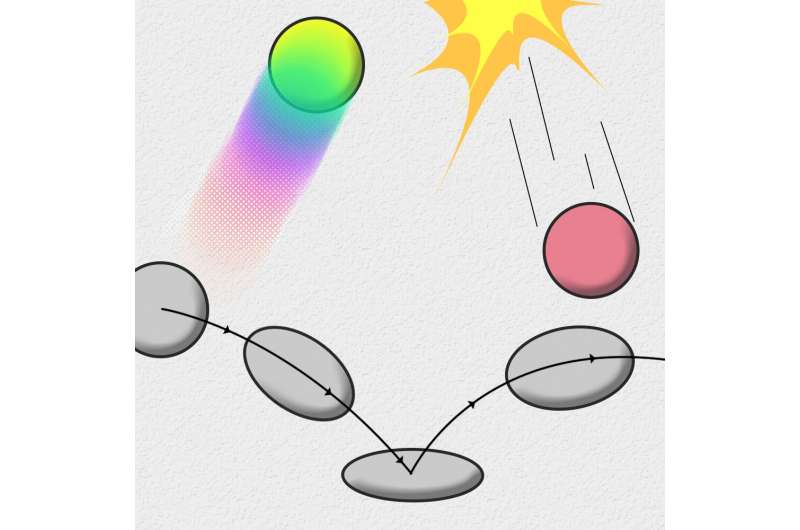October 27, 2022 feature
Study explores how visual effects in videogames help players to make sense of game worlds

Visual effects (VFX) can help to make videogames more engaging and immersive for players. However, they are often also designed to support players, for instance, by pointing them to specific locations or highlighting helpful game features.
Researchers at University of California, Santa Cruz (UCSC) have recently carried out a study investigating the ways in which VFX can help videogame players to make sense of the virtual worlds and environments they are navigating. Their paper, pre-published on arXiv and presented at the IEEE VIS Workshop on Visualization for the Digital Humanities (VIS4DH), could guide the future development of both videogames and data visualization tools.
"Our study mostly builds upon our engagement with two distinct communities: the data visualization research and the videogame communities," Henry Zhou, one of the researchers who carried out the study, told TechXplore. "The Computational Media department at UCSC has a mixture of scholars interested in both media artifacts. The paper originated from my colleague Angus G. Forbes' observation of a general minimalist aesthetic as practicing wisdom in the data visualization research community, especially when it comes to visual effects (VFX) and animation."
Some data visualization researchers argue that VFX and animations should only be used sparingly, as they increase the visual load on devices. Videogame developers, on the other hand, generally use many VFX and animations, as they can help players to make sense of game environments, rules and features.
Zhou and Forbes, by examining how VFX are used in existing videogames, sought to better understand how VFX can aid videogame players' sensemaking. They hope that this would also highlight valuable opportunities for the design of data visualization tools.
"At first, we picked games that we're familiar with, and then tried to diversify the selection in terms of genres like puzzles, actions and strategy games," Zhou explained. "We either looked through playthrough videos or played the game ourselves and then took note of what we considered to be VFX/animation. Afterward, we tried to think about how these effects are utilized to help players make sense of the gameplay situation."
Through their analyses, Zhou and Forbes were able to identify three of the most common uses of VFX in videogames. Firstly, they found that these effects can help to draw a player's attention to specific game elements, such as objects that are most relevant to the gameplay and that the players should interact with to win the game or complete tasks.
Secondly, VFX can help to represent the game's mechanics (i.e., the key rules governing a game's actions and goals). For instance, if players are expected to shoot a specific target, VFX might help them to aim more accurately, showing them the area in the environment toward which they are directing their shot.
Finally, VFX are also used to signal important gameplay events that are about to take place or that just occurred. These events could include anything from an enemy attacking to time running out on a timer or a transition to a different gameplay modality.
"I think it is valuable to open a communication channel between data visualization designers and game designers," Zhou said. "Much can be said about the similarities and differences between videogames and data visualization tools. For example, the term 'mechanics' is a common term in the video game community to describe what happens to the game system when actions are carried out."
The recent work by Zhou and Forbes describes some of the valuable ways in which VFX can help to represent different game events or features. The strategies identified in their paper could also be applied to data visualization tools to make them more engaging and intuitive.
"There are two branches of possibilities that I am curious to explore about the 'mechanics' of a visualization tool," Zhou said. "First, if an interface/visualization also develops 'mechanics' of user interactions, such as linking and brushing, can visual effects and animation help make these interactions richer and embed more information? Second, as data visualization is mostly about visualizing static data, while games are more about interacting with a dynamic and changing system, could we explore the design space where the user is interacting with an active simulation system (i.e., like a game system), so that VFX/animation become a much more relevant design tool?"
This recent work challenges the "minimalist" approach currently employed by many developers creating data visualization tools. Zhou and Forbes hope that their observations will ultimately pave the way for the greater use VFX and animations in data visualization designs, to support users' sensemaking processes.
"We see a lot of data visualization examples, outside of academic research communities, with various aesthetic decisions, like NYT data journalist articles and educational YouTube videos," Zhou added. "Academic data visualization tool research often focuses on the novel data encoding and views that their tools enable, but not particularly how they make aesthetic decisions to make the tool more engaging for the intended audience. This steering of engagement is not just about aesthetics—these decisions also impact the way users make sense of the tool and insights they can take from using them."
In his next studies, Zhou would like to further explore the use of VFX in both videogames and data visualization tools, to better map the similarities and differences between these two media domains. In addition, he plans to apply the ideas summarized in his recent work to create prototypes of features for visualization tools. For instance, he is currently collaborating with another researcher at UCSC to create a VFX-supported data visualization tool for high school education.
More information: Hongwei Zhou, Angus G. Forbes, Data feel: Exploring visual effects in video games to support sensemaking tasks. arXiv:2210.03800v1 [cs.HC], arxiv.org/abs/2210.03800
© 2022 Science X Network



















